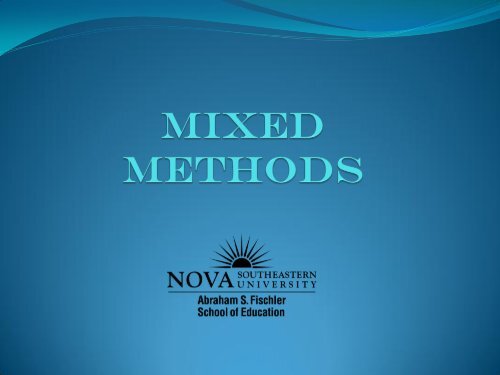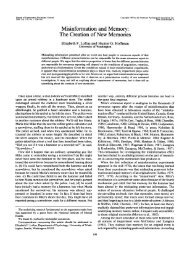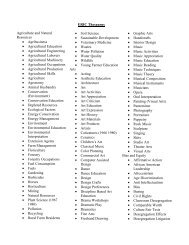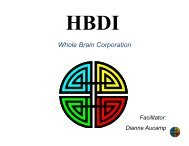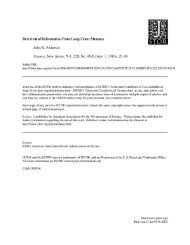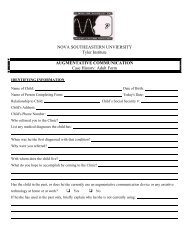What Is Mixed Methods Research? - 1
What Is Mixed Methods Research? - 1
What Is Mixed Methods Research? - 1
- No tags were found...
Create successful ePaper yourself
Turn your PDF publications into a flip-book with our unique Google optimized e-Paper software.
Overview• <strong>Mixed</strong> <strong>Methods</strong> <strong>Research</strong>, Defined• Quantitative <strong>Research</strong>• Qualitative <strong>Research</strong>• When to use <strong>Mixed</strong> <strong>Methods</strong> <strong>Research</strong>• Types of <strong>Mixed</strong> <strong>Methods</strong> <strong>Research</strong> Designs• Key Characteristics• Steps in Conducting a <strong>Mixed</strong> <strong>Methods</strong> study• Evaluating a <strong>Mixed</strong> <strong>Methods</strong> study
<strong>Mixed</strong> <strong>Methods</strong> <strong>Research</strong>, Defined• A mixed methods research design is a procedure forcollecting, analyzing, and “mixing” both quantitativeand qualitative research and methods in a single studyto understand a research problem.• To utilize this design effectively, you must understandboth quantitative and qualitative research.• Philosophical ApproachesCreswell , J. (2012). Educational research: Planning, conducting, and evaluating quantitative and qualitative research(4thed.). Upper Saddle River, NJ: Pearson Education.
Quantitative <strong>Research</strong>• A type of educational research in which the researchdecides what to study; asks specific, narrow questions,collects quantifiable data from participants (a largenumber of participants); analyzes these numbersusing statistics; and conducts the inquiry in anunbiased, objective manner.• Postpositivism – singular reality; objective; deductive
Quantitative <strong>Research</strong> (cont’d)• Generally attempts to quantify variables of interest;questions must be measureable.• Example:• <strong>What</strong> is the relationship between graduate students’level of interaction, measured by the number of ‘hits’ inthe course, and students’ grades in an online researchmethods course?
Quantitative Methodology• Generally involves collecting numerical data that canbe subjected to statistical analysis• Examples of data collection methodologies• Performance Tests• Personality Measures• Questionnaires (with closed-ended questions or openendedbut transferred to quan data)• Content Analysis• The data is generally referred to as “hard” data
Qualitative <strong>Research</strong>• A type of educational research in which the researcherrelies on the views of participants; asks broad, generalquestions; collects data consisting largely of words (ortext) from participants; describes and analyzes thesewords for themes; and conducts the inquiry in asubjective, biased manner.• Constructivism – multiple realities; biased; inductive
Qualitative <strong>Research</strong> (cont’d)• “There are times we wish to know not how many orhow well, but simply how” (Shulman, 1988, p. 7).• Example:• “<strong>What</strong> are the factors that influence a graduate students’experience in an online research methods course?”
Qualitative MethodologyGenerally involves listening to the participants’ voiceand subjecting the data to analytic induction (e.g.,finding common themes)More Exploratory in natureExamples of data collection methods Interviews Open-ended questionnaires Observations Content analysis Focus Groups
Steps for Conductinga <strong>Mixed</strong> <strong>Methods</strong> StudyIdentify the datacollection strategy andtype of designStep 3Identify a rationalefor a mixed methodsstudyStep 2Develop quantitative,qualitative, and mixedmethods questionsPrioritySequenceVisualizationStep 4Determine if a mixedmethods study isfeasibleStep 1Collect quantitativeand qualitative dataAnalyze dataseparately orconcurrentlyStep 5Step 6Write the report as aone- or two-phasestudyStep 7
When to Use <strong>Mixed</strong> <strong>Methods</strong>Designs• When both quantitative and qualitative data, together,provide a better understanding of your researchproblem than either type by itself.• When one type of research (qualitative orquantitative) is not enough to address the researchproblem or answer the research questions.• Pragmatism – practicality; multiple view points;biased and unbiased; subjective and objectiveCreswell , J. (2008). Educational research: Planning, conducting, and evaluating quantitative and qualitative research(3rd ed.). Upper Saddle River, NJ: Pearson Education.
When to Use <strong>Mixed</strong> <strong>Methods</strong>(cont’d)• To incorporate a qualitative component into anotherwise quantitative study• To build from one phase of a study to another• Explore qualitatively then develop an instrument• Follow-up a quantitative study qualitatively to obtainmore detailed informationCreswell , J. (2012). Educational research: Planning, conducting, and evaluating quantitative and qualitative research(4thed.). Upper Saddle River, NJ: Pearson Education.
<strong>Mixed</strong> <strong>Methods</strong> <strong>Research</strong>Methodology• Utilizes both quantitative and qualitative datacollection methodologies.• Examples• Interviews and Questionnaires• Performance Tests and Observation• Questionnaires and follow up Focus groups• Document analysis, Performance Tests, Questionnaire,and Interviews
<strong>What</strong> <strong>Is</strong> <strong>Mixed</strong> <strong>Methods</strong> <strong>Research</strong>?A mixed methods research design is aprocedure for collecting, analyzing, and“mixing” both quantitative andqualitative research and methods in asingle study to understand a researchproblem.
Key Characteristics of<strong>Mixed</strong> <strong>Methods</strong> Designs: Rationale• Rationale• Test findings of first phase• Explain results of first phase in more detail• Provide a more complete understanding than eitherquantitative or qualitative alone• Collecting both quantitative and qualitative data• Numeric data• Text data
<strong>Mixed</strong> <strong>Methods</strong> LegendNotationQUANQUALDefinedQuantitatively driven study.Qualitatively driven study.quanQuantitative data is secondary to qualitative data.qualQualitative data is secondary to quantitative data.+→Indicates that quantitative and qualitative data arecollected concurrently.Indicates that quantitative and qualitative data arecollected sequentially.
Key Characteristics of <strong>Mixed</strong> <strong>Methods</strong>Designs: Priority and Sequence• Priority• Equal weight• QUAN carries more weight than qual• QUAL carries more weight than quan• Sequence• Collect both quantitative and qualitative data at the sametime• Collect quantitative data first, followed by qualitative data• Collect qualitative data first, followed by quantitative data
Key Decisions In Choosing A<strong>Mixed</strong> <strong>Methods</strong> Study• The level of interaction between the quantitative andqualitative strands• The priority of the strands• The timing of the strands• Where and how to mix the strands18
The Convergent Parallel DesignQuantitativeData Collectionand AnalysisQualitativeData Collectionand AnalysisCompareor relateInterpretation20
The Convergent Design• The researcher:• Collects quantitative and qualitative data concurrently• Analyzes the two data sets separately• Mixes the two databases by merging the results duringinterpretation (and sometimes during data analysis)21
Purposes for the ConvergentDesign• Obtain a more complete understanding from twodatabases• Corroborate results from different methods• Compare multiple levels within a system22
When to Use the ConvergentDesign• Choose this design if:• Need to collect both types of data in one visit to the field• Both types of data have equal value for understandingthe research problem• Have quantitative and qualitative research skills• Can manage extensive data collection activitiesindividually or with a team23
Convergent Design• Philosophical assumptions:• Best suited to an "umbrella" paradigm such aspragmatism• Common variants:• Parallel-databases variant• Data-transformation variant• Data-validation variant24
Strengths: Convergent Design• Intuitive• Efficient• Lends itself to teams25
Challenges: Convergent Design• Requires substantial effort and expertise• <strong>Is</strong>sues related to the samples and sample sizes• Difficult to converge two sets of different data• How to resolve discrepant results26
The Explanatory Sequential DesignQuantitativeData Collectionand AnalysisFollow upwithQualitativeData Collectionand AnalysisInterpretation27
The Explanatory Design• The researcher:• Starts by collecting and analyzing quantitative data• Collects and analyzes qualitative data in a second phaseas a follow-up to the quantitative results• Connects the phases by using the quantitative results toshape the qualitative research questions, sampling, anddata collection28
Purposes for the ExplanatoryDesign• To use qualitative data to help explain quantitativeresults that need further exploration• To use quantitative results to purposefully select bestparticipants for qualitative study29
When to Use the ExplanatoryDesign• Choose this design if:• <strong>Research</strong>er and research problem are quantitativelyoriented• Know important variables and instruments are available• Participants available for second data collection• Have time to conduct two phases• Have limited resources and need to collect and analyzeone data type at a time• New questions emerge from quantitative results30
Explanatory Design• Philosophical assumptions:• Begin from postpositivism for the quantitative phase• Shift to constructivism for the qualitative phase• Common variants:• Follow-up explanations variant• Participant-selection variant31
Strengths: Explanatory Design• Appealing to quantitative researchers• Straightforward to implement two phases• Final report can be written in two phases• Lends itself to emergent approaches32
Challenges: Explanatory Design• Two phases require lengthy time to implement• Difficult to secure IRB approval when second phase cannotbe specified before first phase complete• Need to decide what results to follow up• Must decide criteria for selecting participants• Need to contact participants for a second round of datacollection33
The Exploratory Sequential DesignQuantitativeData Collectionand AnalysisFollow upwithQualitativeData Collectionand AnalysisInterpretation34
The Exploratory Design• The researcher:• Collects and analyzes qualitative data first followed byquantitative data• Analyzes the qualitative data and uses results to build tothe subsequent quantitative phase• Connects the phases by using the qualitative results toshape the quantitative phase by specifying researchquestions and variables, developing an instrument,and/or generating a typology35
Purposes for the ExploratoryDesign• To first explore because variables, theories, hypothesesnot known• To develop an instrument or typology that is notavailable• To assess whether qualitative themes generalize to apopulation36
When to Use the ExploratoryDesign• Choose this design if:• <strong>Research</strong>er and research problem are qualitativelyoriented• Important variables not known and instruments notavailable• Have time to conduct two phases• Have limited resources and need to collect and analyzeone data type at a time• New questions have emerged from qualitative results37
Exploratory Design• Philosophical assumptions:• Begin from constructivism for the qualitative phase• Shift to postpositivism for the quantitative phase• Common variants:• Theory-development variant• Instrument-development variant38
Strengths: Exploratory Design• Straightforward to design, implement, and report• Quantitative component can make the qualitativeapproach more acceptable to quantitative-biasedaudiences• <strong>Research</strong>er produces a product, such as an instrument• Lends itself to emergent approaches39
Challenges: Exploratory Design• Two phases require lengthy time to implement• Difficult to specify quantitative procedures whenapplying for initial IRB approval; may have to applytwice• Deciding the qualitative findings to use forquantitative phase• Procedures for developing a valid and reliableinstrument40
The Embedded DesignQuantitative (or Qualitative) DesignQuantitative (or Qualitative)Data Collection and AnalysisQualitative (or Quantitative)Data Collection and Analysis(before, during, or after)Interpretation41
Embedded Approachcollect qualExperimental Design (can use quasiexperimentaldesign)QUAN designs to beused within anEmbedded ApproachCorrelationalExplanatory designPredictive designExperimentalBetween-subjects-pre- and posttest designWithin-subjects-cross-over design-factorial designcollect qualCorrelational Design
The Embedded Design• The researcher:• Collects and analyzes quantitative and qualitative datawithin a quantitative research design, qualitativeresearch design, or research procedure• Collection and analysis of secondary data set occursbefore, during, and/or after the primary methods43
Purposes for the EmbeddedDesign• To address different questions that call for differentmethods• To enhance an experiment such as by• improving recruitment procedures• examining the intervention process• explaining reactions to participation44
When to Use the EmbeddedDesign• Choose this design if:• Have expertise with the primary design• Are comfortable with the primary orientation• Have little prior experience with the supplementalmethod• Resources limit placing equal priority on both methods• Need for a secondary data set emerges45
Embedded Design• Philosophical assumptions:• Worldview may reflect the primary approach, usepragmatism for a concurrent approach, or shift in asequential approach• Common variants:• Embedded experiment• Embedded correlational• Embedded instrument development and validation• <strong>Mixed</strong> methods case study• <strong>Mixed</strong> methods narrative research• <strong>Mixed</strong> methods ethnography46
Strengths: Embedded Design• May require less time and fewer resources• Improve the larger design with supplemental data• Fits team approach well• May be able to publish results separately• Appealing to those accustomed to traditional designs47
Challenges: Embedded Design• Need expertise in primary design and mixed methods• Must specify purpose for collecting the supplemental data• Must decide when to collect supplemental data• Results are difficult to integrate• Must consider treatment bias if qualitative data collectedduring experiment48
Light, G. et al. (2009). Assessing the impact of a year-longfaculty development program on faculty approaches toteaching. International Journal of Teaching andLearning in Higher Education, 20(2), 168-181.• Objective: Determine if the Faculty DevelopmentProgram (FDP) impacts teaching style of pre-tenurefaculty.• <strong>Research</strong> Questions• Quantitative – <strong>What</strong> effect did the FDP have onteachers’ approaches to teaching?• Qualitative – (Central) – How did the teachers’teaching strategies change in response to the FDP?• Sub - <strong>What</strong> steps did the teachers take to implement thechange?• <strong>Mixed</strong> Method – How do the qualitative (qual) findingsexplain (expand on) the quantitative (QUAN) results?
• Design. The mixed method design employed was anexplanatory approach with an quasi-experimentaldesign. The quantitative method was quasiexperimentalbetween-subjects approach utilizing apre- and posttest control group design. Qualitativedata was collected at two time points postcollect qualintervention.Assignment N = 81 Pretest Treatment Posttest qual qual (n = 25)NR n = 52 ATI FDP ATI CriticalReportsNR n = 29 ATI - ATI CriticalReportsNR = non-randomATI = Approach to Teaching InventoryFDP = Faculty Development ProgramInterviews
Chapter 1: Introduction• Statement of the Problem• The topic.• The research problem.• Background and justification (philosophical view points).• Deficiencies in the evidence.• Audience.• Definition of Terms
Chapter 2: Literature Review• Lit Review should include relevant headings andsubheadings. Following the lit review the purposestatement then research questions should bepresented.• Purpose Statement -(a) the overall content aim, (b) the type ofmixed method design, (c) the forms of data collection that will beused (very general), (d) the data collection site(s), and (e) thereason for collecting both forms of data (see Creswell, 2007).• <strong>Research</strong> Questions• Quantitative• Qualitative• <strong>Mixed</strong> <strong>Methods</strong>
Chapter 3: Methodology• Participants• Quantitative.• Qualitative.• Instruments• Procedures• Design• Quantitative data.• Qualitative data.• Data analysis.• Limitations
<strong>Mixed</strong> <strong>Methods</strong> Template• Go to the ARC website for the <strong>Mixed</strong> <strong>Methods</strong> specifictemplate:http://www.fischlerschool.nova.edu/appliedresearch/procedures_and_resourcesThank you for your Attention!


